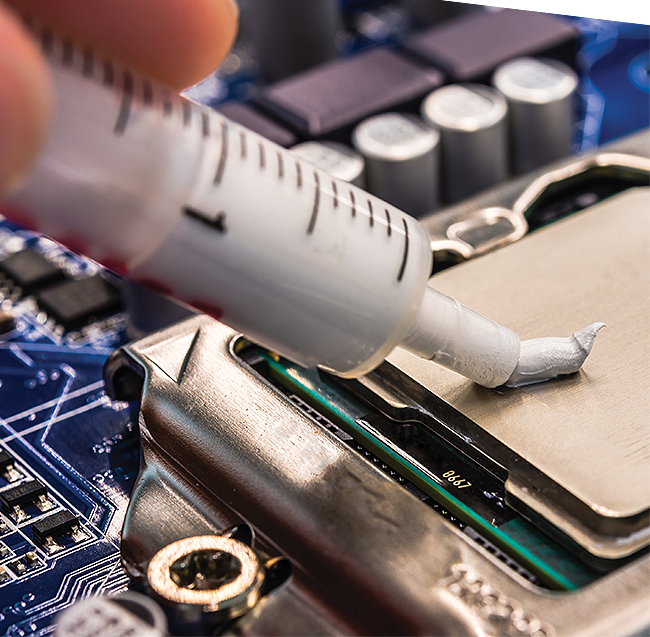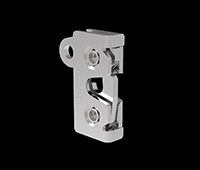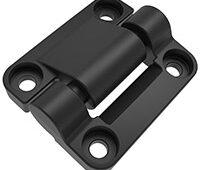by Paven Patel, General Manager and Barry Siroka, Business Development Manager, EpoxySet
The process of evaluating and choosing an adhesive is easier when you consider a few key parameters.
Choosing the best adhesive for a specific application can be complex. There are many variables to consider and numerous types of chemistries with different capabilities. An understanding of the following parameters will help narrow the choices. Selecting the correct adhesive will reduce the number of products you need to evaluate and increase the likelihood of success.

Thermal cure materials can be cured at room temperature or with heat. Heat-cured thermal adhesives can require high temperatures, which might be detrimental to components, but, in general, they will cure faster with higher properties.
1. Substrates. Knowing the materials that you will bond is important. Certain adhesives adhere better to ceramic or glass. “Metal” and “plastic” are generic terms that encompass many different types of materials, so knowing the exact substrate is essential for determining the correct adhesive. For example, ABS and polytetrafluoroethylene (Teflon) are both plastics, but PTFE requires an acid etch to achieve a bond whereas ABS can usually be bonded with just an alcohol cleaning.
2. Cleanliness of the parts. Most adhesives require that the substrates be prepared properly. Whether it’s just a simple cleaning or the ability to do more complex operations (such as abrasion, chemical etch or plasma treatment) will all come into play in selecting an adhesive.
3. Viscosity. The viscosity must be considered. Low viscosity, or thin, products are best for thin bonds or for applications requiring wicking. Thixotropic materials, which won’t run, are best for use in vertical applications.
4. Thermal cure versus UV cure. UV cure adhesives are usually one part and can be cured quickly. They must be exposed to UV light to cure, so at least one of the substrates must allow transmission of UV light. Thermal cure materials can be cured at room temperature or with heat. Heat-cured thermal adhesives can require high temperatures, which might be detrimental to components, but, in general, they will cure faster with higher properties.
5. Working life. Determine how much work life is desired. Remember that working life (time before the material gels) is generally related to cure time. For thermal cure materials, the longer the working life, the longer the cure time (at room temperature) usually. Single-part UV-cured materials can be cured quickly, and the working life doesn’t apply.
6. Configuration. The dimensions of the parts and how they fit together are important to determine the best material. Larger parts and thicker bond gaps may require a slower cure to reduce shrinkage. Certain adhesives are designed to work best with thinner gaps.
7. Required performance. Questions you should ask before selecting an adhesive:
Does the adhesive need to form a structural bond?
Ideally, a structural bonding material will create a finished part that is as strong as the substrates. As stated earlier, knowledge of the composition of the substrates helps decide the best adhesive and preparation to accomplish an ultimate bond. Also, understanding the configuration of the parts to be bonded will determine the types of adhesives for use. With most adhesives the larger the surface area of the mated parts, the stronger the bond.
The bond gap is also critical. Various adhesive chemistries work best with certain gaps. In general, cyanoacrylates and anaerobics need the thinnest bond line, whereas epoxies and urethanes are better with thicker gaps. Every chemistry varies depending on how they were formulated, but these are general rules.

When evaluating adhesives and potting materials, confirm that they work on a performance level and on a production level. How will material be applied? It is common to have a product that works perfectly for the application only to find out later that processing it on the production floor is either inefficient and wasteful, or just not possible.
How much mechanical stress will there be on the bond during use?
This may seem obvious, but the forces on the adhesive joint and the direction of those forces have a major impact on the adhesive to be used. Some chemistries have excellent tensile strength (strength in a horizontal direction) and little shear strength (strength in a vertical direction). Other considerations would be whether there are any compressive forces or torsion on the joint. Adhesives may be formulated to be more flexible or with fillers to compensate for these stresses.
Will stresses be consistent or intermittent?
Some adhesives can take extreme stress for short periods, but not withstand stress over longer periods. Others may hold up to long consistent stress as long as it is not brought on suddenly.
Other types of stresses may also be of concern. For example, autoclaving is a standard practice in many industries; however, many adhesives cannot withstand autoclaving. It is important to consider all stresses when selecting adhesives.
What are the temperature requirements during processing and use?
This can be an extremely important parameter. Materials with low-temperature cures may not withstand high temperatures during use. Adhesives designed for high-temperature uses might only cure with heat, so the adhesive will have to be exposed to dry heat (an oven or a heat element).
The exposure temperatures during use are critical. Also consider whether the parts will be temperature cycled. Many materials that will withstand high temperatures will crack when cycled to low temperatures, and low-temperature materials might lose their strength at high temperatures.
What optical properties (if any) are important?
Optical properties may be important for certain applications. If light transmission is important, know the wavelength being transmitted and the duration. You may also want to consider the refractive index of the substrates. Certain chemistries will not remain clear over long exposure to UV radiation.
Does the cosmetic appearance matter?
Some adhesive chemistries can be easily colored, but others cannot. Some chemistries will have lot-to-lot variations, so the final appearance can change. In applications requiring specific colors (especially for consumer products), it may be necessary to ensure that lots can be color-matched.
These are some of the more important issues, although for any specific application, there can be other considerations before selecting the right candidate. It is not often feasible to know all required parameters before choosing, but it is important to have as much information as possible to make an educated decision. There is no substitute for sampling and evaluating a product. Testing often reveals previously unconsidered parameters.
Considerations for application
When evaluating adhesives and potting materials, it also important to confirm they work on a performance level and on a production level. How will material be applied? It is a common occurrence that engineers or project managers approve a product that works perfectly for the application only to find out later that processing it on the production floor is either inefficient and wasteful, or just not possible. Consider dispensing, mixing and applying concepts early to save time and money down the line and avoid production or launch delays.
Mix ratio
One of the biggest issues facing production lines while using two-part polymer systems are the mix ratios. Mix ratios vary from product to product and unfortunately are not as simple as 1:1 by weight and volume. Some mix ratios are also less critical allowing for higher degrees of tolerance. Alternatively, slight changes in a mix can result in changes in the physical characteristics of the product. For instance, polyamide-based epoxy systems are forgiving in mix ratios. If the product calls for a 100:80 mix ratio by weight and the actual mix ratio is off by even 10%, the finished polymer and the characteristics are not drastically different, nor should it affect its performance. A tin catalyzed silicone is vulnerable to changes in mix ratio. A 10% increase in catalyst can accelerate the polymerization process and decrease work life, not allowing operators enough time to pot or encapsulate the part, leading to waste material.
Amine and imidazole cured epoxies (as well as many urethane systems) with an incorrect ratio will result in a finished adhesive with diminished properties. If a ratio specific material is the best choice, ensure that manufacturing processes are set up accordingly to produce the best and consistent results.
While uneven mix ratios should not deter one from choosing a product, many prefer even ratios to reduce risk of mistakes. There are several options for high-efficiency application of adhesive systems. Many products that have even volumetric mix ratios (1:1. 2:1, 4:1) are also available in dual barrel cartridges. These types of cartridges come in different sizes and are convenient because there is no risk of weighing or mixing mistakes. These dual barrel cartridges can be dispensed through applicator guns that can be operated either manually (like a caulking gun) or pneumatically for higher efficiency.

Even volumetric mix ratios are available in dual barrel cartridges, like the one shown here. Cartridges eliminate the rick of weighing or mixing mistakes and can be dispensed through applicator guns operated manually or pneumatically.
While evaluating, and ultimately choosing, an adhesive or encapsulating compound can be an exhausting effort, it can be made easier by considering some of the elements discussed in this article. The more information you have on the application helps eliminate a majority of options and makes it easier in filtering the variety of products available. Contacting the experts is also a major step in choosing the right product. Adhesive suppliers tend to have a vast amount of knowledge on their products and where they are best used. Ultimately, evaluating adhesives comes down to choosing one (or a few) and testing them in your application before deciding. As mentioned before, there is no substitute for sampling and testing products on your own.
EpoxySet
www.epoxyset.com
Filed Under: Actuators, FASTENING • JOINING • locks • latches • pins





Tell Us What You Think!